The Bovine Lactoferrin Market is estimated to be valued at USD 1035.7 million in 2025 and is projected to reach USD 4491.0 million by 2035, registering a compound annual growth rate (CAGR) of 15.8% over the forecast period.
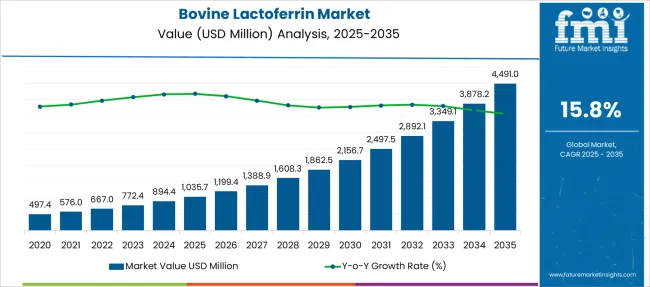
| Metric | Value |
|---|---|
| Bovine Lactoferrin Market Estimated Value in (2025 E) | USD 1035.7 million |
| Bovine Lactoferrin Market Forecast Value in (2035 F) | USD 4491.0 million |
| Forecast CAGR (2025 to 2035) | 15.8% |
The bovine lactoferrin market is witnessing notable growth as a result of rising demand for immune-boosting nutritional ingredients, especially in infant and maternal health segments. Bovine lactoferrin's multifunctional properties, including antimicrobial, antiviral, and anti-inflammatory effects, have positioned it as a vital component in both clinical and over-the-counter nutrition products.
Increased awareness regarding gut health and disease prevention has further supported its integration into functional food formulations. Regulatory approvals for inclusion in infant formula and dietary supplements across major markets such as the United States, Europe, and Asia Pacific have accelerated commercial acceptance.
Technological advancements in purification and formulation techniques have also enhanced its bioavailability and stability in final applications. As consumers increasingly seek science-backed, naturally derived ingredients for preventive health, bovine lactoferrin is expected to maintain a strong foothold across nutraceutical and pediatric nutrition landscapes.
The market is segmented by Type and Application and region. By Type, the market is divided into Freeze-dried and Spray-dried. In terms of Application, the market is classified into Infant Formula, Dietary Supplements, Pharmaceuticals, Food, and Other Applications. Regionally, the market is classified into North America, Latin America, Western Europe, Eastern Europe, Balkan & Baltic Countries, Russia & Belarus, Central Asia, East Asia, South Asia & Pacific, and the Middle East & Africa.
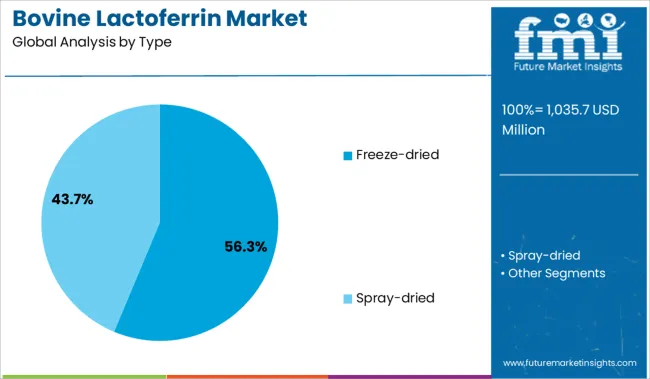
The freeze dried segment is projected to account for 56.30% of the total market revenue by 2025 within the type category, positioning it as the leading segment. This growth is attributed to the superior stability, long shelf life, and preservation of bioactivity offered by freeze drying technology.
The method ensures minimal degradation of functional proteins, making it highly suitable for infant formula and nutraceutical products. Manufacturers prefer freeze dried bovine lactoferrin for its ability to retain purity and efficacy during processing and storage.
Additionally, the process supports compliance with stringent safety and quality standards required in pediatric and clinical nutrition markets. As a result, freeze dried formulations continue to lead due to their reliability, functionality, and compatibility with sensitive applications.
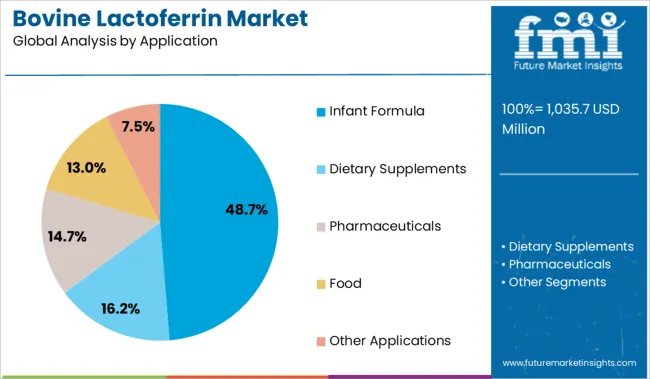
The infant formula segment is expected to contribute 48.70% of total market revenue by 2025 under the application category, making it the most prominent use case. This dominance is driven by increasing global awareness of early childhood nutrition and the critical role lactoferrin plays in enhancing immune defense and iron absorption in infants.
Clinical research validating its benefits in neonatal development has led to widespread inclusion in premium infant nutrition products. Growing demand in emerging economies, coupled with rising birth rates and improved access to fortified baby food, is supporting segment expansion.
Moreover, manufacturers are increasingly emphasizing bioactive ingredients in formula composition to closely mimic human breast milk. This sustained focus on functional enhancement and infant health optimization continues to anchor infant formula as the dominant application in the bovine lactoferrin market.
Lactoferrin has anti-inflammatory properties that may be important in the pathophysiology of COVID-19 cases. The lack of a cure or vaccine for the virus resulted in high consumption of immunity boosters in 2024. Precautions for COVID-19 infection have found widespread applications, resulting in an increase in demand for lactoferrin-based products in the historical period.
For example, Jatcorp announced planned to launch 5 new lactoferrin-enriched immune powder formulas in China in May 2024. This release was made in response to the increased market demand for immune-boosting functional ingredients as a result of the COVID-19 pandemic.
However, rising demand for bovine lactoferrin among the general population has prompted a few market participants to focus on expanding their production capacities and will boost market growth over the upcoming decades. According to a report from Future Market Insights (FMI), from 2020 to 2025, sales witnessed significant growth, registering a CAGR of 10%.
Cost-effective Production Processes Implementation to Compel Sales Growth
Currently, several technology-oriented industries are focusing on developing a cost-effective method of manufacturing these products. Several researchers are also working to determine the effectiveness of this ingredient for delivering specific drugs in cancer treatment.
This, combined with an increase in the number of working women in the Asia Pacific and Europe region, tends to result in a decrease in the frequency of breastfeeding, causing a greater consumption of infant formula. Oral bovine lactoferrin, associated with the beneficial properties of lactoferrin in infant formula, is growing significantly, and the adaptation of this protein during infant formula manufacturing, cruising the bovine lactoferrin supplement market.
Conagen, Inc., for example, established a cost-effective lactoferrin production process using microbial fermentation technology in April 2024.
The increasing relevance of naturally produced supplements over chemical molecules motivates the market expansion
The increasing influence of naturally produced supplements over chemical molecules among the overall population has boosted the deployment of dietary supplements with the addition of lactoferrin in both developed and developing nations.
As a result, market players are progressively concentrating their efforts on these fields to make a profit. Furthermore, clinical trials to examine the effects of this component in the healthcare industry have increased by a factor of 25 to 30. As a result of this diversification of applications, a high intake of these products is anticipated to propel the bovine lactoferrin supplement market growth during the 2025 to 2025 period.
The high cost of lactoferrin and lactoferrin-containing items is restricting the adoption
Despite rising global demand for sophisticated nutritional and infant formula ingredients, specific factors are limiting the market growth. The elevated cost of items comprising bovine lactoferrin as a component is one of them.
Food, nutritional supplements, infant formula, and other equivalent segments require different amounts of protein purification ranging from 90.0% to 99.0%. The greater the purity demanded, the more expensive it is to produce, causing it to cost more.
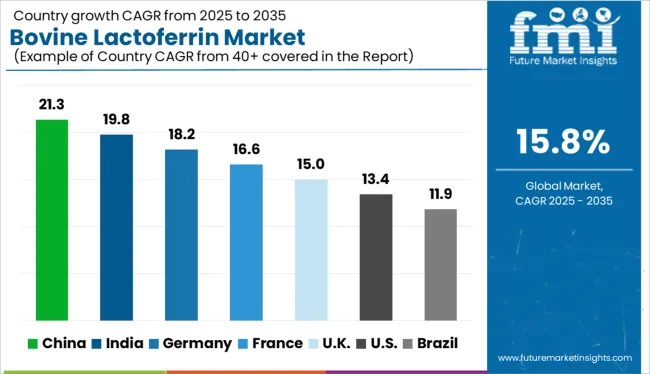
The increased production of infant formula is credited to the region's dominance
In 2024, the Asia Pacific market is estimated to be valued at USD 1035.7 Million. With a sales revenue of 42.5% in 2025, Asia Pacific emerged as the biggest regional market. During the forecast timeframe, the regional market is expected to uphold its position. Regional revenue growth, led by India, China, and Japan, can be attributed to the increased population and consumer buying ability.
In contrast to most other regions, Asia Pacific has a significant number of medium and small industries. Furthermore, high consumer acknowledgment of infant nutrition, personal care, and pharmaceutical drugs, as well as the preference of customers for organic foods, are expected to fuel the region's lactoferrin market.
Other important factors cruising the booming market for infant formula in this region are the decrement in breastfeeding rates and quality control of commercial bovine lactoferrin.
The growing incidence of Digestive Disorders has elevated Product Sales
In 2024, North America was the second-largest leading region for lactoferrin. The United States has emerged as the region's biggest market. The increased incidences of digestive issues have enhanced product sales across the nation.
Moreover, a spike in the proportion of specialty stores, hypermarkets, and supermarkets, as well as incentivized marketing infrastructure used by brand owners to boost sales, is anticipated to drive market growth in the near future. Furthermore, the presence of prominent market players in the region is influencing the market in the region by implementing multiple marketing plans and strategies, including advertising, to enhance business scope.
The specific benefits of the spray-dried segment contribute to industry growth
In 2025, the freeze-dried segment dominated the market. The high-grade quality of the final product, antioxidant properties, and substantially greater iron-binding potential are some of the key aspects attributed to segmental dominance.
The spray-dried segment, on the other hand, is anticipated to expand at a notable CAGR over the coming years. Specified advantages, such as flexible, scalable, and manageable particle methodologies, are aiding the expansion of this segment. Aside from that, spray drying is suitable for bulk applications.
The clinical efficacy of these ingredients, such as improved immunity and digestion, drives the market
In 2024, the infant formula segment led the lactoferrin market, with a profit share of more than 40%. From 2025 to 2035, the segment is predicted to expand at a consistent CAGR.
The surge in the prevalence of clinical data confirming infant formula integration with lactoferrin, as well as shifting customer dynamics toward infant supplementary foods, are anticipated to fuel the growth.
The popularity of infant nutrition is primarily from emerging nations, owing to high disposable income, hectic work timetables, and increased prevalence of iron deficiency among infants.
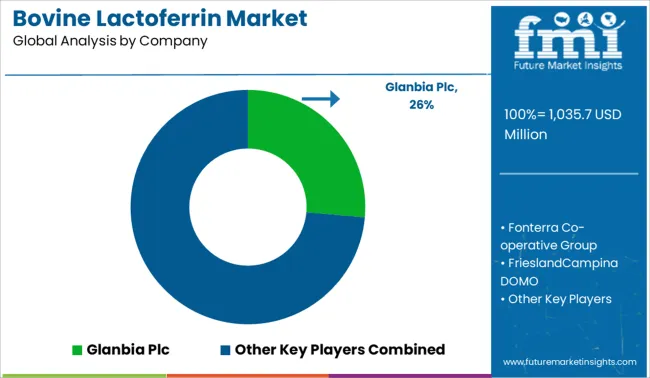
Key players in the Bovine Lactoferrin market are MILEI GmbH, Bega Cheese Ltd., Fonterra Co-operative Group Friesland Campina DOMO, Beston Global Food Company Ltd., SAVENCIA SA, Saputo Dairy Australia Pty Ltd., Freedom Foods Group Limited, Synlait Ltd., Glanbia Plc. and Ingredia among others.
| Report Attributes | Details |
|---|---|
| Market Value in 2025 | USD 1035.7 million |
| Market Value in 2035 | USD 4491.0 million |
| Growth Rate | CAGR of 15.8% from 2025 to 2035 |
| Base Year for Estimation | 2025 |
| Historical Data | 2020 to 2025 |
| Forecast Period | 2025 to 2035 |
| Quantitative Units | Revenue in USD Billion and CAGR from 2025 to 2035 |
| Report Coverage | Revenue Forecast, Volume Forecast, Company Ranking, Competitive Landscape, Growth Factors, Trends, and Pricing Analysis |
| Segments Covered | Product Type, Application, Region |
| Regions Covered | North America; Latin America; Europe; South Asia & Pacific; East Asia; Middle East & Africa |
| Key Countries Profiled | USA, Canada, Brazil, Mexico, Mexico, Germany, United Kingdom, France, Spain, Italy, India, Malaysia, Singapore, Thailand, China, Japan, South Korea, Australia, New Zealand, GCC Countries, South Africa, Israel |
| Key Companies Profiled | Glanbia Plc.; Fonterra Co-operative Group; Freisland Campine DOMO; Milei GmbH; Bea Bionutrients; Beston Global Australia Pty Ltd.; Saputo Dairy Pty Ltd.; Synlait Ltd.; Ingredia; Savencia SA; Freedom Food Group Limited |
| Customization | Available Upon Request |
The global bovine lactoferrin market is estimated to be valued at USD 1,035.7 million in 2025.
The market size for the bovine lactoferrin market is projected to reach USD 4,491.0 million by 2035.
The bovine lactoferrin market is expected to grow at a 15.8% CAGR between 2025 and 2035.
The key product types in bovine lactoferrin market are freeze-dried and spray-dried.
In terms of application, infant formula segment to command 48.7% share in the bovine lactoferrin market in 2025.






Full Research Suite comprises of:
Market outlook & trends analysis
Interviews & case studies
Strategic recommendations
Vendor profiles & capabilities analysis
5-year forecasts
8 regions and 60+ country-level data splits
Market segment data splits
12 months of continuous data updates
DELIVERED AS:
PDF EXCEL ONLINE
Bovine Pericardial Valve Market Size and Share Forecast Outlook 2025 to 2035
Bovine High-Mountain Disease Market Size and Share Forecast Outlook 2025 to 2035
Bovine Brain Extract Size and Share Forecast Outlook 2025 to 2035
Bovine Gelatin Market
Hydrolyzed Bovine Collagen Market
Middle East & Africa Hydrolyzed Bovine Collagen Market Size and Share Forecast Outlook 2025 to 2035
Lactoferrin Market Analysis - Size, Share & Forecast 2025 to 2035
Demand for Lactoferrin Premiumization in Immune SKUs in EU

Thank you!
You will receive an email from our Business Development Manager. Please be sure to check your SPAM/JUNK folder too.
Chat With
MaRIA